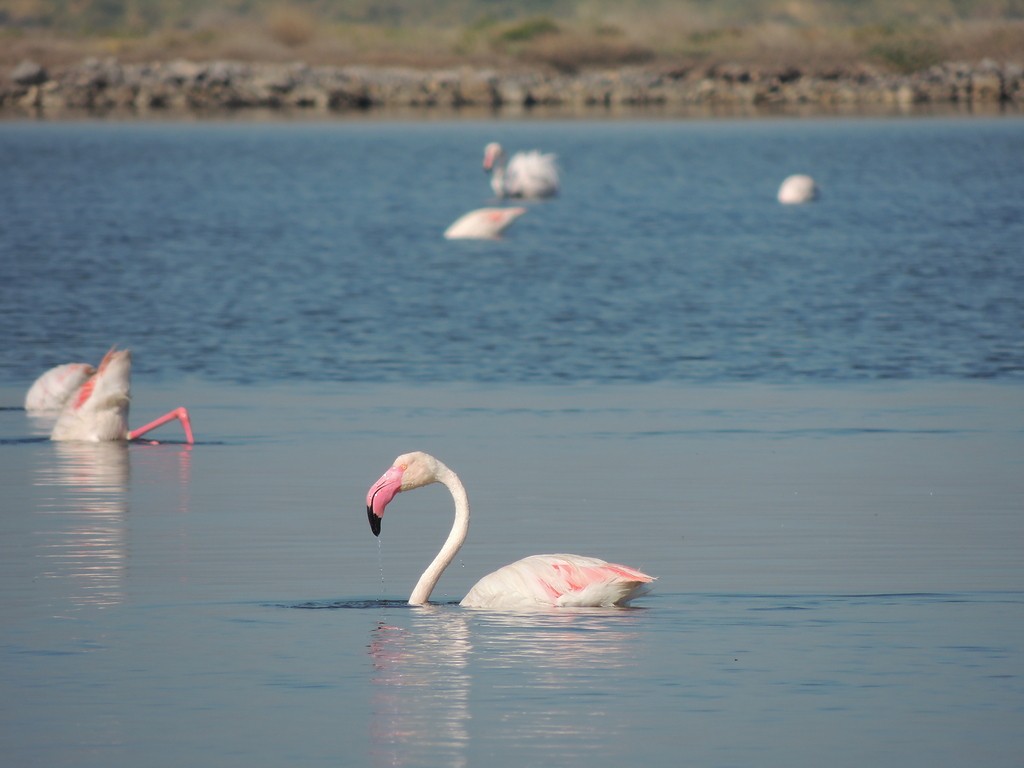Greater Flamingo
A species of Greater Flamingos, Also known as Mediterranean Flamingo Scientific name : Phoenicopterus roseus Genus : Greater Flamingos
Greater Flamingo, A species of Greater Flamingos
Also known as:
Mediterranean Flamingo
Botanical name: Phoenicopterus roseus
Genus: Greater Flamingos
Content
Description People often ask General Info
 Photo By Medeniacus , used under CC-BY-SA-4.0 /Cropped and compressed from original
Photo By Medeniacus , used under CC-BY-SA-4.0 /Cropped and compressed from original Description
The greater flamingo is the largest living species of flamingo, averaging 110–150 cm (43–59 in) tall and weighing 2–4 kg (4.4–8.8 lb). The largest male flamingos have been recorded at up to 187 cm (74 in) tall and 4.5 kg (9.9 lb). Most of the plumage is pinkish-white, but the wing coverts are red and the primary and secondary flight feathers are black. The bill is pink with a restricted black tip, and the legs are entirely pink. The call is a goose-like honking. Chicks are covered in gray fluffy down. Subadult flamingos are paler with dark legs. Adults feeding chicks also become paler, but retain the bright pink legs. The coloration comes from the carotenoid pigments in the organisms that live in their feeding grounds. Secretions of the uropygial gland also contain carotenoids. During the breeding season, greater flamingos increase the frequency of their spreading uropygial secretions over their feathers and thereby enhance their color. This cosmetic use of uropygial secretions has been described as applying "make-up". 
Size
1.3 m
Colors
Red
White
Life Expectancy
33 years
Nest Placement
Ground
Feeding Habits
Greater Flamingo primarily feeds on algae, mollusks, aquatic worms, crustaceans, and other invertebrates. It forages by filtering water and mud through its bill. Greater Flamingo has specialized adaptations such as a unique beak shape and filtering lamellae to efficiently extract food.
Habitat
Greater Flamingo primarily inhabit shallow wetlands with saline or alkaline conditions. These environments typically include salt lakes, coastal lagoons, intertidal mudflats, and man-made saltworks. Broadly, greater Flamingo's distribution spans across regions that offer such habitats, including coastal estuaries, deltas, and marshlands. In non-breeding seasons, they also occupy rice fields, aquaculture ponds, and reservoirs. This preference for wet habitats is mirrored across different geographical regions where greater Flamingo is found.
Dite type
Aquatic invertebrate eater
People often ask
General Info
Feeding Habits
Bird food type
Distribution Area
It is found in parts of Africa, southern Asia (Bangladesh and coastal regions of Pakistan, India, and Sri Lanka), the Middle East (Bahrain, Cyprus, Iran, Israel, Kuwait, Lebanon, Turkey and the United Arab Emirates) and southern Europe (including Albania, Greece, Italy, Montenegro, North Macedonia, Portugal, Spain, and South of France). The most northern breeding spot is the Zwillbrocker Venn in western Germany, close to the border with the Netherlands. They have been recorded breeding in the United Arab Emirates at three different locations in the Abu Dhabi Emirate. In Gujarat, a state of India, flamingos can be observed at the Nal Sarovar Bird Sanctuary, Khijadiya Bird Sanctuary, Flamingo City, and in the Thol Bird Sanctuary. They remain there during the entire winter season. 
Species Status
Not globally threatened.
Scientific Classification
Phylum
Chordates Class
Birds Order
Flamingos Family
Flamingos Genus
Greater Flamingos Species
Greater Flamingo